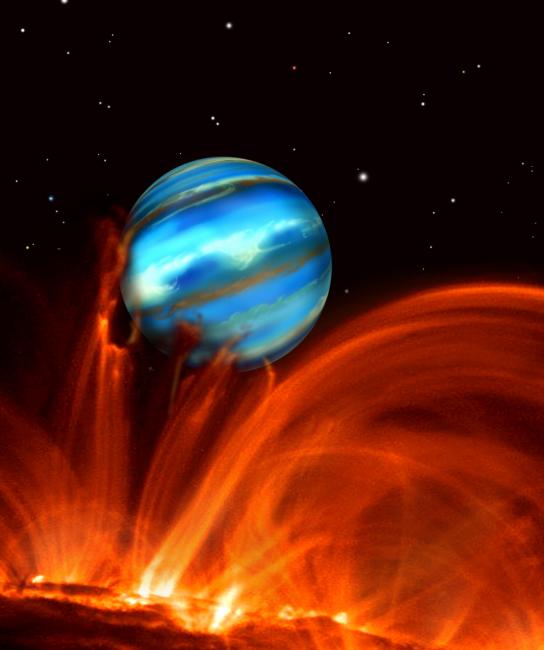
Cambridge, MA
Two teams of astronomers announced at a press conference today that they have directly detected light from two known planets orbiting distant stars. This discovery opens a new frontier in the study of extrasolar planets. Researchers now can directly measure and compare such planetary characteristics as color, reflectivity, and temperature.
A team led by David Charbonneau of the Harvard-Smithsonian Center for Astrophysics (CfA) will publish their detection of the planet TrES-1 in the June 20th issue of The Astrophysical Journal. A team led by Drake Deming of the Goddard Space Flight Center (GSFC) published their observations of the planet HD 209458b in today's online issue of Nature.
"It's an awesome experience to realize we are seeing the glow of distant worlds," said Charbonneau. "When I first saw the data, I was ecstatic."
Each of the two target planets periodically crosses in front of and behind its star. When in front, the planet partially eclipses the star and blocks a small portion of the star's light. Similarly, the system dims slightly when the planet disappears behind its star since the star blocks the planet's light. By observing this "secondary eclipse," astronomers can tease out the faint signal of the planet from the overwhelming light of the nearby star.
Planets Can't Hide The Heat
Charbonneau and his colleagues used the Infrared Array Camera (IRAC), a Smithsonian-developed instrument aboard NASA's Spitzer Space Telescope, to observe TrES-1 in the infrared region of the spectrum. Deming and his associates used Spitzer's Multiband Imaging Photometer for Spitzer (MIPS) to observe HD 209458b.
"Planets like TrES-1 are tiny and faint compared to their stars, but the one thing they can't hide is their heat," said Charbonneau. "We are like detectives. Previous clues told us the planet must be there, so we put on our 'infrared goggles' and suddenly, it popped into view."
Infrared offers an advantage because the star outshines the planet by a factor of 10,000 in visible light, while in the infrared the star is only about 400 times brighter, making it easier to pick out a planet's feeble light. Astronomers compare the challenge to trying to spot a firefly buzzing next to a searchlight.
Planet TrES-1
IRAC team members Lori Allen and Tom Megeath (CfA) planned the TrES-1 observations, which required precise timing to catch the system just before and after the secondary eclipse, as well as precise pointing. Their experience and familiarity with the performance of the IRAC camera were crucial in obtaining the best data possible. Allen and Megeath also provided insights into IRAC instrument features encountered during data analysis.
"Teasing out the signal from TrES-1 was both challenging and exciting," said Allen. "We were actually seeing light from another world hundreds of light-years away from us, circling around another sunlike star."
Although two groups previously claimed to have directly photographed an extrasolar planet, neither one is confirmed and neither orbits a sun-like star.
Using Spitzer data combined with previous measurements, Charbonneau and his colleagues confirmed that TrES-1, which orbits its star at a distance of 4 million miles, has a temperature of about 1,450 degrees Fahrenheit (1060 Kelvin). They also calculated that the planet has a reflectivity of only 31%, meaning it absorbs the majority of the star's light that falls on it.
CfA researcher Guillermo Torres modeled the dynamics of the TrES-1 system to constrain the planet's orbit. He determined that the orbit has been made very nearly circular by the tidal effect of the nearby star, as expected.
Future Exoplanet Research
Charbonneau is quick to point out that the achievement of directly detecting an extrasolar planet's light is only the beginning. "We've caught our first 'firefly.' Now we want to study a swarm of them."
Astronomers expect the Trans-Atlantic Exoplanet Survey (TrES) network, which spotted TrES-1, to locate additional "hot Jupiters." That ground-based network is designed to spot planets orbiting bright stars, which can be more easily studied with Spitzer and other instruments. By comparing many "hot Jupiter" planets, researchers hope to determine what gases their atmospheres contain and how their composition was affected by when and how they formed.
"We never imagined we would find planets as strange and varied as we have. Who knows what new worlds are waiting for us?" said Charbonneau.
The paper on the TrES-1 finding is authored by Charbonneau, Allen, Megeath, and Torres; Roi Alonso (IAC), Timothy Brown (NCAR), Ronald Gilliland (STScI), David Latham (CfA), Georgi Mandushev (Lowell Observatory), Francis O'Donovan (Caltech), and Alessandro Sozzetti (University of Pittsburgh/CfA).
NASA's Jet Propulsion Laboratory, Pasadena, Calif., manages the Spitzer Space Telescope mission for NASA's Science Mission Directorate, Washington. Science operations are conducted at the Spitzer Science Center, Pasadena, Calif. JPL is a division of California Institute for Technology, Pasadena.
Headquartered in Cambridge, Mass., the Harvard-Smithsonian Center for Astrophysics (CfA) is a joint collaboration between the Smithsonian Astrophysical Observatory and the Harvard College Observatory. CfA scientists, organized into six research divisions, study the origin, evolution and ultimate fate of the universe.
David A. Aguilar
Director of Public Affairs
Harvard-Smithsonian Center for Astrophysics
617-495-7462
daguilar@cfa.harvard.edu
Christine PulliamPublic Affairs Specialist
Harvard-Smithsonian Center for Astrophysics
617-495-7463
cpulliam@cfa.harvard.edu